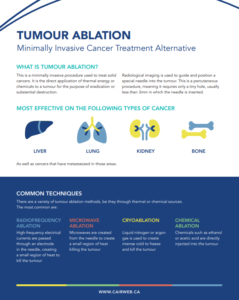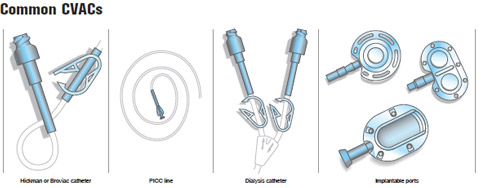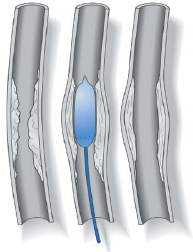Access Menu
Tumour Ablation
Minimally Invasive Cancer Treatment Alternative
What is Tumour Ablation?
This is a minimally invasive procedure used to treat solid cancers. It is the direct application of thermal energy or chemicals to a tumour for the purpose of eradication or substantial destruction. Radiological imaging is used to guide and position a special needle into the tumour. This is a percutaneous procedure, meaning it requires only a tiny hole, usually less than 3mm in which the needle is inserted.
Most Effective on the Following Types of Cancer:
- Liver
- Kidney
- Lung
- Bone
- As well as cancers that have metastasized in these areas.
Surgery or Ablation?
Patients that are not suitable for surgery can have tumour ablation as a safer alternative that can be either palliative or curative for their symptoms. Also, small tumours, can be effectively treated with tumour ablation preventing a much more invasive surgery. Ablation can dramatically shrink the size of a tumour, and for those that are 3cm or less in diameter has been an effective means of complete treatment, meaning that no residual cancer is present.
Common Techniques
There are a variety of tumour ablation methods, be they through thermal or chemical sources. The most common are:
- Radiofrequency Ablation: high-frequency electrical currents are passed through an electrode in the needle, creating a small region of heat to kill the tumour
- Microwave Ablation: microwaves are created from the needle to create a small region of heat killing the tumour
- Cryoablation: liquid nitrogen or argon gas is used to create intense cold to freeze and kill the tumour
- Chemical Ablation: chemicals such as ethanol or acetic acid are directly injected into the tumour
Access
A 2014 study looking at hospitals in Ontario identified that under 45% of hospitals offered Tumour Ablation, meanwhile 75% of hospitals would be willing to provide those services if the appropriate funding was provided. The hospitals that did offer ablation procedures were focused in the Toronto area and in Southwest Ontario.
Benefits
- Cancer treatment for patients who aren’t cleared for surgery
- High level of success
- Short recovery time
- Proven results
Poster
List of facilities
Please note that the information contained on this page is intended solely for informational purposes and should not be used as a substitute for professional medical advice, diagnosis, or treatment. The list provided here includes only members of the Canadian Association for Interventional Radiology (CAIR) who have indicated that they perform the specified procedure. It is important to understand that this is not a comprehensive list of all physicians or facilities capable of performing this procedure.
The names, physicians, and facilities listed are members of CAIR and have provided their information voluntarily. While we strive to keep this information up to date and accurate, CAIR does not guarantee the accuracy, completeness, or timeliness of the information provided. The inclusion of any name in this list does not imply endorsement by CAIR or a recommendation of their services.
Patients are encouraged to conduct their own research and consult with a qualified healthcare provider to make informed decisions about their health care. CAIR assumes no liability for any actions taken based on the information provided on this page, nor for any errors or omissions in the content. Use of this information is at your own risk.
For further inquiries or to verify the credentials and qualifications of a healthcare provider, please contact the appropriate licensing board or authority in your region.
ALBERTA
Calgary
Foothills Hospital
1403 29th St NW
Calgary, Alberta T2N2T9
Canada
Dr. Stefan Przybojewski
Dr. Jason Wong
Phone: 403-944-4634
Fax: 403-944-1687
Email: stefan.przybojewski@albertahealthservices.ca
Email: wongjk@ucalgary.ca
Type of Ablative Procedures:
- Liver
- Lung
- Bone
- Soft tissue
Edmonton
University Hospital – Diagnostic Imaging
8440-112 St NW
Edmonton, Alberta T6G2B7
Canada
Dr. Philippe Sarlieve
Phone: 780-407-7881
Email: philippe.sarlieve@albertahealthservices.ca
Type of Ablative Procedures:
- Liver
- Kidney
BRITISH COLUMBIA
Kelowna
Kelowna General Hospital
2268 Pandosy
Kelowna, British Columbia V1Y1T2
Dr. Nevin de Korompay
Phone: 250-862-4454
Fax: 250-862-4357
Type of Ablative Procedures:
- Liver
- Lung
- Kidney
- Bone
- Soft tissue
New Westminster
Royal Columbian Hospital
330 E Columbia St.
New Westminster, British Columbia V3L3W7
Canada
Dr. Zameer Hirji
Phone: 604-520-4640
Type of Ablative Procedures:
- Liver
- Lung
- Kidney
- Bone
- Soft tissue
Vancouver
Vancouver General Hospital
899 W 15th Avenue
Vancouver, British Columbia V5Z 1M9
Canada
Dr. Anastasia Hadjivassiliou
Phone: 604-875-4111 ext 68612
Email: anastasia.hadjivassiliou@vch.ca
Type of Ablative Procedures:
- Liver
- Kidney
Victoria
Vancouver Island Health Authority
1 Hospital Way
Victoria, British Columbia V8Z6R5
Canada
Dr. Vamshi Kotha
Phone: 250-370-8000 ext. 14208
Email: vamshikotha@gmail.com
Type of Ablative Procedures:
- Liver
- Lung
- Kidney
- Bone
- Soft tissue
Victoria General Hospital
1 Hospital Way
Victoria, British Columbia V8Z6R5
Canada
Dr. Paul Sobkin
Phone: 250- 727-4208
Email: paul.sobkin@islandhealth.ca
Type of Ablative Procedures:
- Liver
- Lung
- Kidney
- Bone
- Soft tissue
MANITOBA
Winnipeg
Health Sciences Center Winnipeg
820 Sherbrook Street
Winnipeg, Manitoba R3A 1R9
Canada
Dr. Alessandra Cassano-Bailey
Phone: 204-787-7620
Type of Ablative Procedures:
- Liver
St Boniface General Hospital
409 Tache Ave
Winnipeg, Manitoba R2H2A6
Dr. Suri Dhaliwal
Type of Ablative Procedures:
- Kidney
Dr. Sookhoo Siuchan
Phone: 204-237-2526
Fax: 204-237-7439
Email: ssookhoo@sbgh.mb.ca
Type of ablative procedures:
- Liver
- Kidney
- Soft tissue
NEW BRUNSWICK
Moncton
Dr. Georges-L.-Dumont University Hospital Centre
330 Université Ave.
Moncton, New Brunswick E1C 2Z3
Canada
Dr. Jordan Court
Phone: 506-862-4000
Email: Jordan.Court@vitalitenb.ca
Type of ablative procedures:
- Liver
- Lung
- Kidney
- Bone
- Soft tissue
NOVA SCOTIA
Cape Breton
Cape Breton Regional Hospital
118 Crescent Street, Sydney, Nova Scotia B1S 2Z8
Canada
Dr. Navid Tofighirad
Phone: 437-988-2171
Type of ablative procedures:
- Kidney
Halifax
QEII Health Sciences Centre
VGH, Victoria Building – 3rd floor North Wing, Dept of Radiology, 1276 South Park Street
Halifax, Nova Scotia B3H 4B2
Canada
Dr. Mike Rivers-Bowerman
Phone: 902-473-5477
Fax: 902-425-6199
Email: michael.rivers-bowerman@nshealth.ca
Website: https://medicine.dal.ca/departments/department-sites/radiology/contact/faculty/mike-rivers-bowerman.html
Type of ablative procedures:
- Liver
- Kidney
ONTARIO
Barrie
Royal Victoria Regional Health Centre
201 Georgian Drive
Barrie, Ontario L4M6M2
Canada
Dr. Arshdeep Sidhu
Phone: 905-728-9802
Email: asidhu@wedi.ca
Website: https://georgianvit.com
Type of ablative procedures:
- Liver
- Lung
- Kidney
- Bone
- Soft tissue
Hamilton
Juravinski Cancer Centre
699 Concession Street
Hamilton, Ontario L8V 5C2
Dr. Sriharsha Atheya
Phone: 905-521-2100
Type of ablative procedures:
- Liver
- Lung
- Kidney
- Bone
- Soft tissue
St Joseph Healthcare Hamilton
50 Charlton Ave E
Hamilton, Ontario L8N 4A6
Canada
Dr. Oleg Mironov
Phone: 905-522-1155 ext. 35387
Fax: 905-540-6576
Type of ablative procedures:
- Liver
- Lung
- Kidney
- Bone
- Soft tissue
Kingston
Kingston Health Sciences Centre
76 Stuart St
Kingston, Ontario K7L2V7
Dr. Ben Mussari
Phone: 613-548-2301
Email: ben.mussari@kingstonhsc.ca
Type of ablative procedures:
- Liver
- Lung
- Kidney
Dr. Alexandre Menard
Phone: 613-549-6666, ext 4902
Email: Alexandre.Menard@kingstonhsc.ca
Type of ablative procedures:
- Liver
- Lung
- Kidney
London
London Health Sciences Centre
C2-200 Victoria Hospital-LHSC 800 Commissioners Road East
London, Ontario N6A 5W9
Dr. Amol Mujoomdar
Phone: 519-685-8500 ext 54965
Fax: 519-667-6872
Type of ablative procedures:
- Liver
- Lung
- Kidney
- Bone
- Soft tissue
Western University
LHSC-VH, 800 Commissioners Rd E
London, Ontario N6A5W9
Dr. Derek Cool
Phone: 519-685-8500 ext 54965
Fax: 519-667-6872
Type of ablative procedures:
- Liver
- Kidney
Oshawa
Lakeridge Health
1 Hospital Ct.
Oshawa, Ontario L1G 2B9
Dr. Sean Galante
Phone: 905- 576-8711 ext 33527
Email: vir@lh.ca
Type of ablative procedures:
- Liver
- Kidney
- Bone
- Soft tissue
Peterborough
Peterborough Regional Health Centre
1 Hospital Dr
Peterborough, Ontario K9J 7C6
Canada
Dr. Sohail Zaheer
Type of ablative procedures:
- Liver
- Kidney
Dr. Fady Abdelsayed
Type of ablative procedures:
- Liver
- Kidney
Dr. Nazmus Sakib
Phone: 705-743-2121, ext 5020
Type of ablative procedures:
- Liver
- Kidney
Dr. Kebby King
Phone: 705-743-2121, ext 5020
Type of ablative procedures:
- Liver
- Kidney
Scarborough
Scarborough Health Network
3050 Lawrence avenue east
Scarborough, Ontario M1P 2V5
Canada
Dr. Zain Badar
Phone: 416-431-8167
Email: Zbadar@shn.ca
Type of ablative procedures:
- Liver
- Lung
- Kidney
- Bone
- Soft tissue
St. Catherine
Niagara Health
1200 Fourth Ave
St. Catharines, Ontario L2S0A9
Canada
Dr. Mahmood Albahhar
Type of ablative procedures:
- Liver
- Lung
- Kidney
- Bone
- Soft tissue
Toronto
Humber River Hospital
1235 Wilson Ave
Toronto, Ontario M3M0B2
Dr. Edwin Zhang
Phone: 416-242-1000 ext 63311
Fax: 416-242-1078
Email: Edzhang@hrh.ca
Type of ablative procedures:
- Liver
- Kidney
- Bone
Toronto General Hospital and Mount Sinai Hospital
585 University Avenue, 1-PMB-294
Toronto, Ontario M5G 2N2
Dr. John Kachura
Phone: 416-340-4800 ext. 6779
Fax: 416-593-0502
Email: john.kachura@uhn.ca
Type of ablative procedures:
- Liver
- Lung
- Kidney
- Bone
- Soft tissue
Trillium Health Partners
2200 Eglinton Ave W
Mississauga, Ontario L5M 2N1
Canada
Dr. Tara Graham
Phone: 905-813-1100 ext 6255
Fax: 905-813-3956
Email: tara.graham@thp.ca
Type of ablative procedures:
- Liver
- Lung
- Kidney
Vaughan
Cortellucci Vaughan Hospital
3200 Major MacKenzie Dr W
Vaughan, Ontario L6A 4Z3
Canada
Dr. Peter De Maio
Phone:905-417-2000 ext 2004
Fax: 905-883-0772
Type of ablative procedures:
- Kidney
Windsor
Windsor Regional Hospital
1030 Ouellette Ave
Windsor, Ontario N9A 1E1
Canada
Dr. Jamil Addas
Phone: 519-254-5577
Fax: 519-258-9688
Email: Jamil.addas@wrh.on.ca
Type of ablative procedures:
- Liver
- Lung
- Kidney
- Bone
- Soft tissue
Dr. Matthew Rochon
Phone: 519-254-5577 ext 31330
Email: matthewrochon@gmail.com
Type of ablative procedures:
- Liver
- Lung
- Kidney
QUEBEC
Montreal
CHUM
1090 rue de Bleury
Montreal, Quebec H2Z0B7
Canada
Dr. Ricardo Holderbaum do Amaral
Phone: 514-659-8000
Email: ricardo.amaral.med@ssss.gouv.qc.ca
Type of ablative procedures:
- Liver
- Kidney
- Bone
- Soft tissue
CHUM
1000 St-Denis
Montreal, Quebec H2X 0C1
Canada
Dr. Jean-Sebastien Billiard
Phone: 514-890-8000
Email: js.billiard@umontreal.ca
Type of ablative procedures:
- Liver
- Lung
- Kidney
- Bone
- Soft tissue
Hôpital Sacré Coeur de Montréal
5400 Boul Gouin O
Montreal, Quebec H4J 1C5
Canada
Dr. Ahmed Bentridi
Phone: 514-338-2222 ext 2844
Email: ahmedbentridi@yahoo.fr
Type of ablative procedures:
- Liver
- Lung
- Kidney
- Soft tissue
McGill University Health Centre
1001 Bd Decarie
Montreal, Quebec H4A 3J1
Canada
Dr. Louis-Martin Boucher
Phone: 514-934-1934 ext. 44454
Fax: 514-843-2893
Email: louis-martin.boucher@mcgill.ca
Type of ablative procedures:
- Liver
- Lung
- Kidney
- Bone
- Soft tissue
Sherbrooke
Centre Hospitalier Universitaire de Sherbrooke
3001, 12e av Nord
Sherbrooke, Quebec J1H5H3
Canada
Dr Maxime Noël-Lamy
Phone: 819-346-1110, ext 14964
Fax: 819-829-3296
Email: Maxime.noel-lamy@usherbrooke.ca
Type of ablative procedures:
- Liver
- Lung
- Kidney
- Bone
- Soft tissue
Quebec
CHU de Québec – Hôpital Enfant Jésus
1401 18e Rue
Québec, Quebec G1J 1Z4
Canada
Dr. Jean-Nicolas Racicot
Phone: 418-525-4444, ext 63680
Email: jean-nicolas.racicot.med@ssss.gouv.qc.ca
Type of ablative procedures:
- Liver
- Kidney
- Bone
- Soft tissue
Trois-Rivieres
CIUSSS MCQ – CHAUR
1991 Boul de Carmel
Trois-Rivieres, Québec G8Z 3R9
Canada
Dr. Mathieu Malenfant
Phone: 819-697-3333
Type of ablative procedures:
- Lung
- Kidney
SASKATCHEWAN
Royal University Hospital
103 Hospital Drive
Saskatoon, Saskatchewan S4N0W8
Canada
Dr. Robert Otani
Phone: 306-655-2371
Fax: 306-655-6304
Email: robert.otani@saskhealthauthority.ca
Type of ablative procedures:
- Liver
- Bone

 Angioplasty is a medical procedure that opens upblocked or narrowed blood vessels without surgery. An interventional radiologist, a doctor specially trained in minimally invasive, targeted treatments, performs this procedure. During the angioplasty, the interventional radiologist inserts a very small balloon attached to a thin tube (a catheter) into a blood vessel through a very small incision in the skin, about the size of a pencil tip. The catheter is threaded under X-ray guidance to the site of the blocked artery. When the balloon is in the area of the blockage, it is inflated to open the artery, improving blood flow through the area.
Angioplasty is a medical procedure that opens upblocked or narrowed blood vessels without surgery. An interventional radiologist, a doctor specially trained in minimally invasive, targeted treatments, performs this procedure. During the angioplasty, the interventional radiologist inserts a very small balloon attached to a thin tube (a catheter) into a blood vessel through a very small incision in the skin, about the size of a pencil tip. The catheter is threaded under X-ray guidance to the site of the blocked artery. When the balloon is in the area of the blockage, it is inflated to open the artery, improving blood flow through the area. If you are already a patient in the hospital – your nurses and doctors will give you instructions on how to prepare for your biliary drainage.
If you are already a patient in the hospital – your nurses and doctors will give you instructions on how to prepare for your biliary drainage. If your bile ducts are blocked, the biliary drainage catheter will relieve your symptoms, such as jaundice and itching. Before this drainage procedure was developed, patients with blocked bile ducts had to undergo surgery to drain the bile.
If your bile ducts are blocked, the biliary drainage catheter will relieve your symptoms, such as jaundice and itching. Before this drainage procedure was developed, patients with blocked bile ducts had to undergo surgery to drain the bile.

 Peripheral vascular disease, or PVD, is a condition in which the arteries that carry blood to the arms or legs become narrowed or clogged, interfering with the normal flow of blood. The most common cause of PVD is atherosclerosis (often called hardening of the arteries). Atherosclerosis is a gradual process in which cholesterol and scar tissue build up, forming a substance called “plaque” that clogs the blood vessels. PVD may also be caused by blood clots.
Peripheral vascular disease, or PVD, is a condition in which the arteries that carry blood to the arms or legs become narrowed or clogged, interfering with the normal flow of blood. The most common cause of PVD is atherosclerosis (often called hardening of the arteries). Atherosclerosis is a gradual process in which cholesterol and scar tissue build up, forming a substance called “plaque” that clogs the blood vessels. PVD may also be caused by blood clots.
 There are a number of ways that physicians can open blood vessels at the site of blockages and restore normal blood flow. In many cases, these procedures can be performed without surgery using modern, interventional radiology techniques. Interventional radiologists are physicians who use tiny tubes called catheters and other miniaturized tools, and X-rays to do these procedures.
There are a number of ways that physicians can open blood vessels at the site of blockages and restore normal blood flow. In many cases, these procedures can be performed without surgery using modern, interventional radiology techniques. Interventional radiologists are physicians who use tiny tubes called catheters and other miniaturized tools, and X-rays to do these procedures.